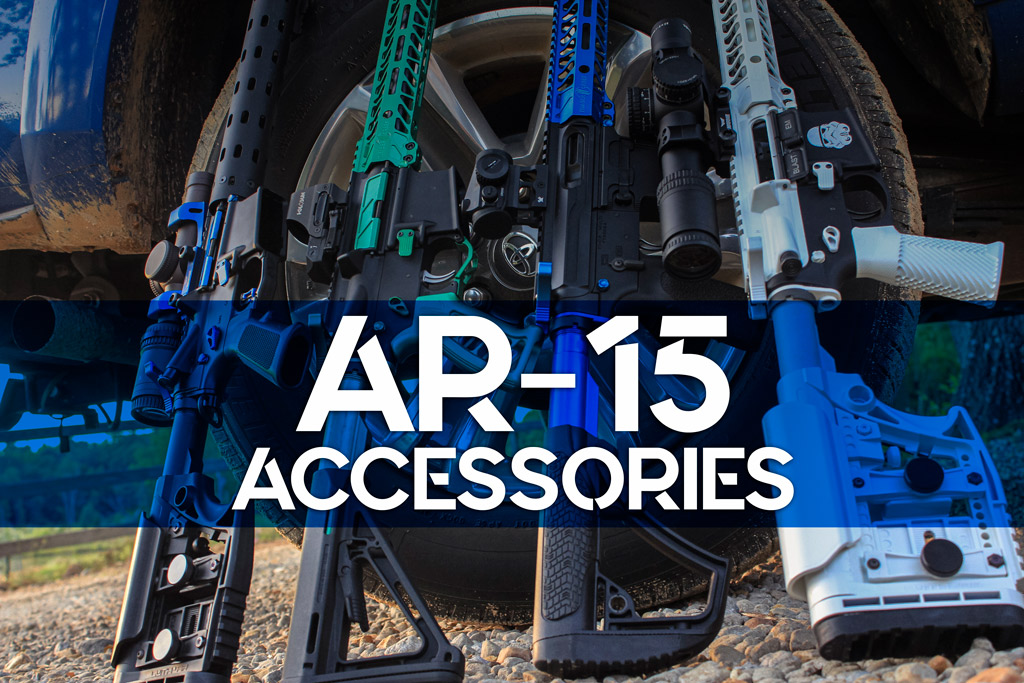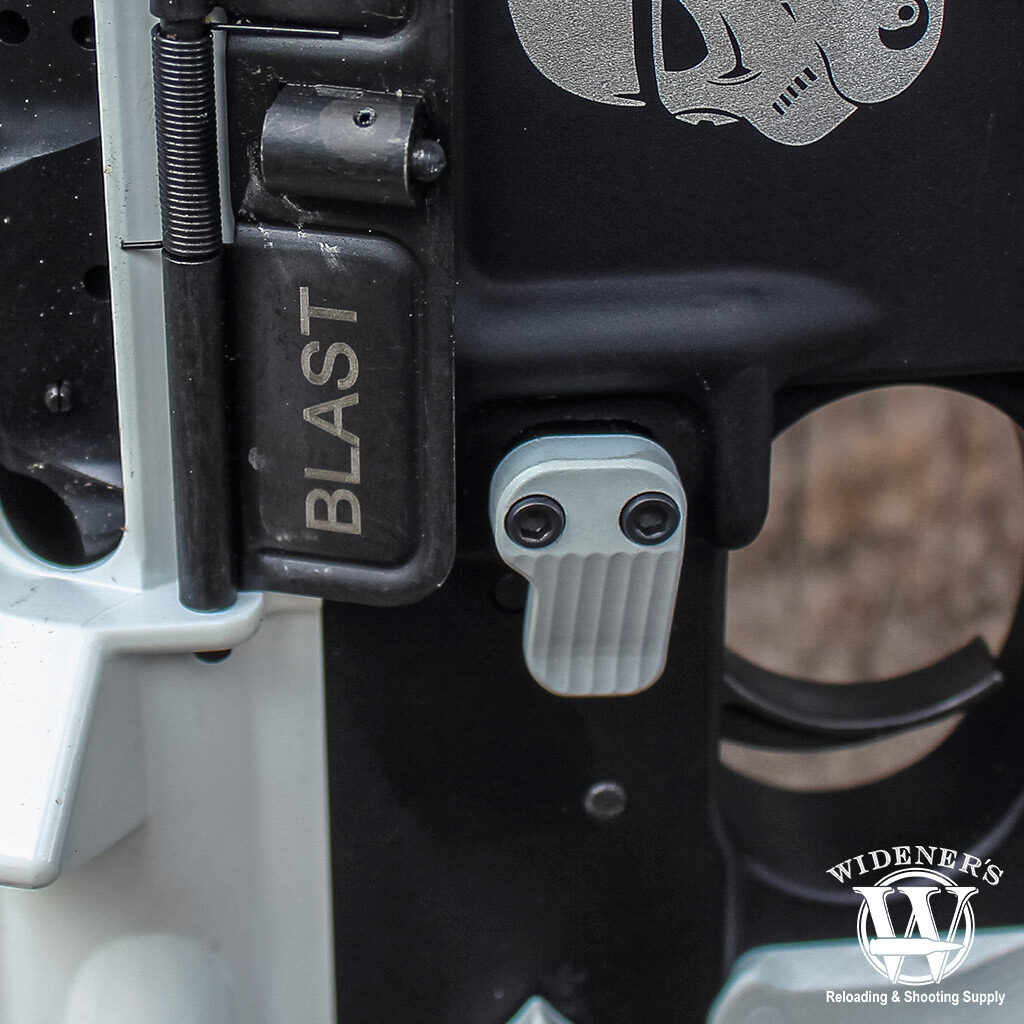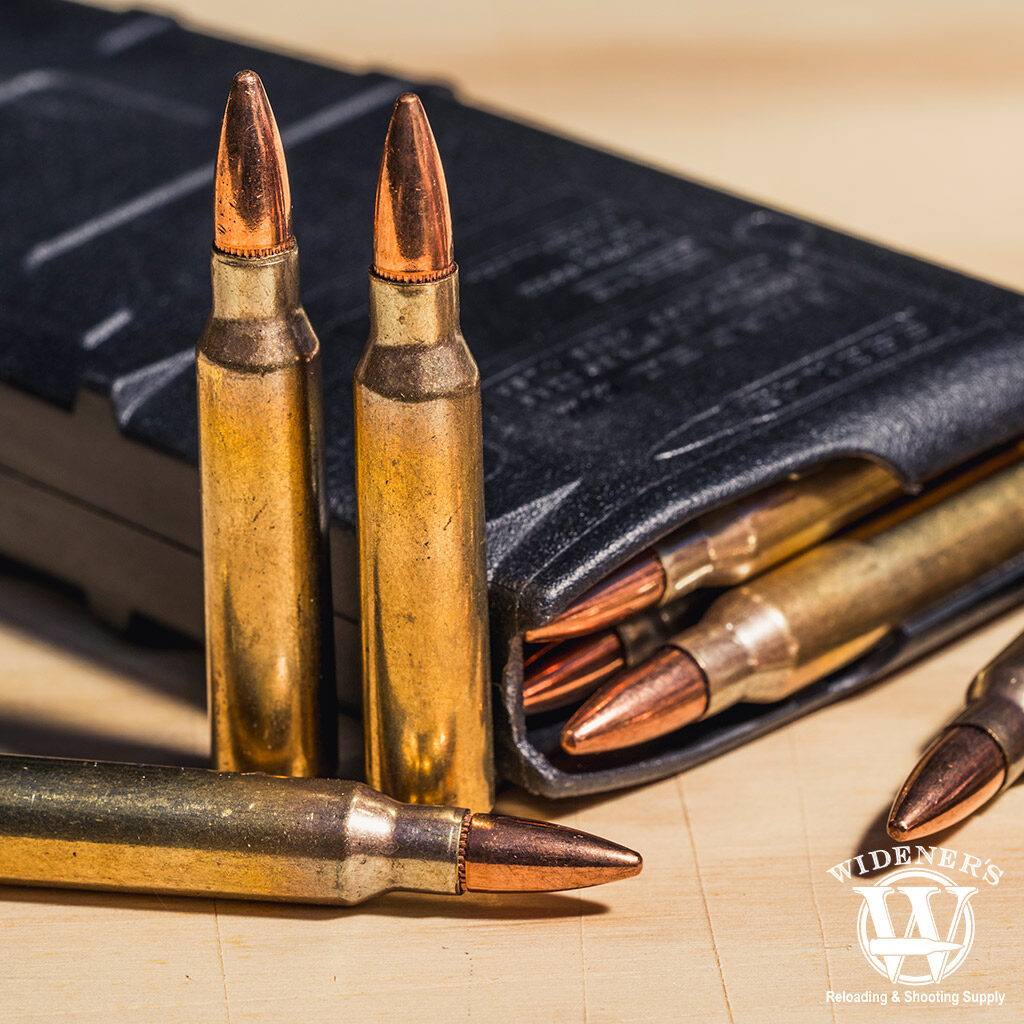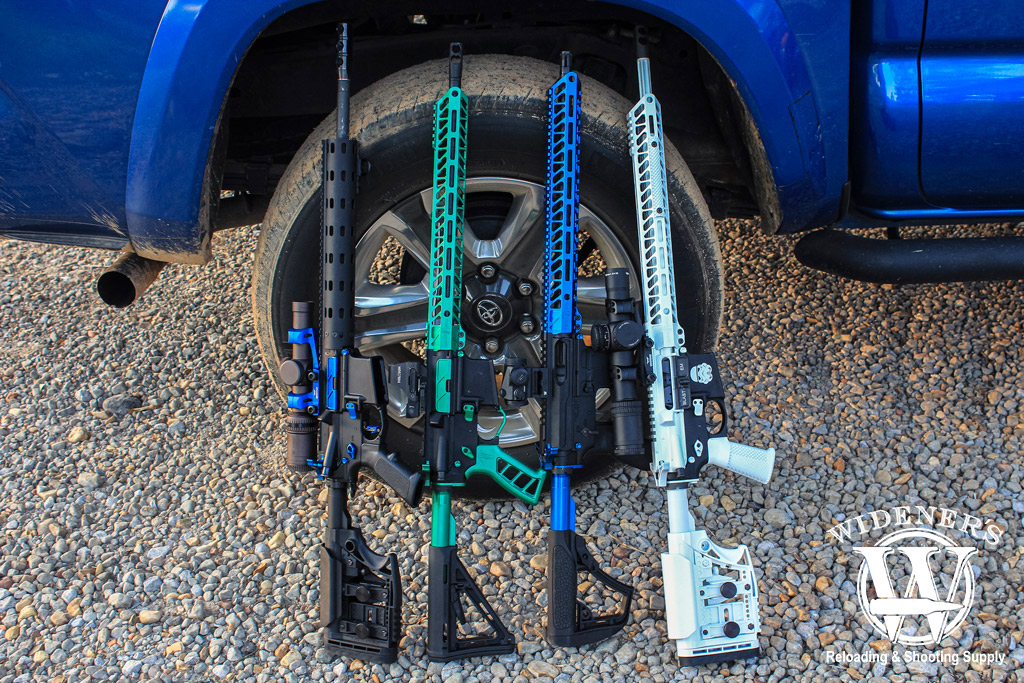

Guest Writer: Kenzie Fitzpatrick
So you’ve purchased a new AR-15, or at the very least, you’ve been window shopping. Buying your first rifle can be exciting, but there are still several factors to consider. What you may not know is which must-have AR-15 accessories you need to customize your rifle to you. Upgrading a rifle with parts that are both functional and fun can improve your aim, recoil management, shooting hand and support hand grip and more.
Here’s a list of the must-have AR-15 accessories you need right now:
- Grip
- Ambidextrous Charging Handle
- Ambidextrous Safety Selector
- Muzzle Brake
- Hand Stop
- Rail Panels
- Oversize Magazine Release
- Buttstock
- Trigger
- Magazines
- Ammo
Must Have AR-15 Accessories
Grip

Get a grip. Better yet, get a textured grip contoured to fit your hand correctly.
The way you grip any gun is one of the shooting fundamentals you need to shoot accurately. Without a proper grip, your aim, and therefore, your accuracy will be off. When choosing a grip, there are two things to consider. Determine if you want to lighten the weight of your rifle overall or if you’re just looking to switch out the grip for better texture.
One recommendation no matter what grip you use is to not choose a grip with finger grooves on it. This goes for any gun. Mass-produced grips with finger grooves already designed are not custom to your grip and can cause you to grip improperly with spacing between your fingers, the opposite of what you want.
My favorite grips are VZ Grips. When picking a grip, choose the level of texture you want to have. For me, I shoot only outdoors and in 3 gun competitions. Those conditions require my slippery, sweaty hands to find purchase on the gun quickly during a stage so I prefer aggressive grip textures.
Ambidextrous Charging Handle

Options are good, ambidextrous options are better. Having the ability to charge your rifle with either hand is priceless.
The best upgrade, in my opinion, for your must-have AR-15 accessories is an ambidextrous charging handle. Most rifles come with a charging handle that is set up for one side charging only. Most factory charging handles are barely wide enough to grip it and pull backward. If you have a scope mounted on your rifle and it’s wider than your rail, it can add extra complexity to finding your charging handle.
There are plenty of manufacturers who make ambi charging handles. I use the Breek Arms Warhammer or Radian Weapons Raptor. An ambidextrous handle allows shooters to pull on the left or right side. Pulling either side quickly activates the intended function.
If, for some reason, your rifle double feeds or brass doesn’t eject from the chamber, you can leverage both sides of the charging handle for a stronger pull to clear a malfunction. Plus, if you’re left-handed, this is pretty much a non-negotiable.
There are pros and cons to wide and slim charging handles. Wide charging handles ensure you can’t miss it under duress. The negative is slinging a rifle on your back or front with a wide charging handle is highly uncomfortable. The complete opposite is true for a slim design handle – easy to miss, yet more comfortable to sling.
Ambidextrous Safety Selector

You need to have the ability to disengage your safety selector switch from either side of your lower receiver.
Similar to the above, an ambidextrous safety selector is another one of the must-have AR-15 accessories that you need to make. A safety selector on both sides makes it easy to manipulate the safety with your thumb or trigger finger. If you shoot a rifle left-handed, this control will change your life, making it quicker to find the safety.
Muzzle Brake

A good muzzle brake can make all the difference in achieving accurate follow-up shots.
A muzzle brake is one of the best accessories to install on your AR-15 to redirect the gas coming out of the gun to lessen the recoil and control the muzzle rise. Muzzle brakes are not all made the same. The best muzzle brake I have discovered recently is the Unrivaled Technologies muzzle brake, a completely adjustable brake, tuneable to your ammo and how you shoot the rifle.
Other brakes I use on my AR-15’s are the UM Tactical R.A.G.E., the SJC Titan, MDT Elite Muzzle brake, VG6 GAMMA, and more. Some muzzle brakes are self-timing while others require a crush washer to install it correctly. Be sure to follow the manufacturer’s instructions when installing a brake on your rifle. Improper installation can damage your threads and barrel.
Muzzle brakes remove felt recoil and give the shooter the ability to get back on target quicker with almost no muzzle rise. Fair warning – standing next to the rifle with a muzzle brake while it’s being shot is not as pleasant of an experience for the witness as it is for the shooter.
Hand Stop

Hand stops come in many shapes and sizes, find one that allows you to operate your rifle without it getting in the way.
Whether you’re upgrading a long rifle or a short barrel rifle, a hand stop can be one of the best accessory upgrades. They keep your support hand safe and keep you from resting on your barrel accidentally. A hand stop should be installed on the handguard of your rifle where your grip ends with your pointer finger. This does two things. This gives your support hand an indexing spot so your grip each time is in the exact same spot.
This also creates a stop and a place to index your handguard on a barricade that guarantees you’re not resting your barrel on the barricade. I have been guilty of this many times when I was learning how to shoot. When you rest your barrel on a prop or barricade, you’re throwing off the accuracy of your barrel causing the bullet to move in a different direction.
Too big of a hand stop on a competition rifle, for example, can be a negative. If you have to shoot off a barricade or in and out of ports, the hand stop can get in the way, so make sure it’s one you can maneuver in and out of positions with easily and not get hung up on props.
A hand stop is one of the must-have AR-15 accessories for a short-barrel rifle. If you grip past the end of the handguard, you risk causing bodily harm to your support hand when firing the gun. I run AR pistols and SBRs with suppressors so a hand stop keeps me from burning my fingers on the suppressor.
Rail Panels

Do you like touching extremely hot metal? If not, I’d recommend getting a set of rail panels for your rifle.
My newest 3-gun rifle features rail panels to keep my hands from slipping when running and shooting. Rail panels can be installed anywhere on your handguard also ensuring that you have the same support hand grip every time.
Once again, I use VZ Grips rail panels and their hand stop. The textures they offer matches that of my rifle grip. The reason I like to use the same textured grip is that it teaches my hands to find the same purchase every time I pick it up creating this muscle memory for me.
Oversize Magazine Release

If you can’t quickly release your magazine, you can’t quickly reload. Don’t skimp on upgrading your factory magazine release.
I can’t overstress this upgrade enough. When you’re operating a rifle, you should be able to do it blindfolded. One of the smallest parts it seems on a stock rifle is the magazine release button. For those of you with smaller hands, it’s sometimes even impossible to reach the magazine release without shifting and changing your rifle grip.
I use the Magpul Enhanced AR Magazine Release not just on my AR-15s now, but also on my Genesis Arms 3 Gun shotgun, which is built on an AR-10 lower. When reloading is key, you should be able to press down quickly without having to search for the button while already moving to grab and load your next magazine.
Buttstock

Choose an adjustable buttstock that’s comfortable and functional for your specific needs.
Sight alignment on a rifle with iron sights, a red dot, or a scope, requires a proper cheek weld on the buttstock. Finding the right buttstock for you is essential to customize the rifle to you. If you’ve ever looked through a scope and seen black rather than the reticle, a different mount or buttstock with an adjustable cheek weld will help you find the reticle.
While there are tons of options out there, a buttstock should be comfortable, durable, and help you see your sights.
For my pistol caliber carbine (PCC), I am using a red dot and therefore do not need to raise my cheek up. I’m also looking to lighten my PCC overall weight so I can keep it held up easily. The Magpul SL line of carbine stocks are easy to adjust and can save weight on a gun.
One buttstock I run on my rifles mounted with scopes is the Luth-AR MBA-3 Buttstock. This buttstock is completely adjustable making it another one of the must-have AR-15 accessories. You can adjust the cheek weld to the exact spot that allows you to see the reticle clearly. The buttstock is also adjustable to lengthen your length of pull. If you ever need to sling your rifle and don’t have a QD by your buffer tube the MBA features multiple attachment points for a sling.
At the end of the day, the only person that can pick the right buttstock for you, is you. Make sure to match it to the purpose of your rifle and what optic you plan to use.
Triggers
Ok, I admit it, I’m a trigger snob. There are a ton of AR-15 trigger options out there which can make finding the right trigger seem overwhelming. First step? Define what the purpose of your rifle is. For me, it’s about competing. So, it’s important to have a competition trigger that I can use in multiple rifle setups.
For that reason, I run the Hyperfire ECLipse trigger. I’m able to run this versatile trigger in my 9mm PCC, my 3-Gun Stag Arms rifle, and in my Genesis Arms shotgun. That way when I’m competing, I don’t have to learn a new trigger each time I pick up a gun.
There a single-stage triggers, two-stage triggers, adjustable pull-weight triggers, and many other options. You need to match your trigger to whatever purpose your gun is. For a home, or self-defense rifle, I’d recommend a heavier pull-weight trigger. If you’re looking to compete, I’d recommend a lighter pull-weight trigger.
Magazines

The Pmag by Magpul is one of the most popular polymer AR-15 magazines.
It’s hard to go wrong with the classic GI-stamped metal magazines for your new AR-15. However, some rifles do like specific branded magazines better than others. That’s just the way it is. The best course of action is to try a few different magazines in your new rifle and see which option runs the best. Thankfully, AR magazine options are plentiful and affordable for the most part.
How many magazines do you need? If you’re a first-time gun owner, go ahead and plan on picking up at least two additional magazines at the time of purchase. Most new rifles include one magazine in the case, so that gives you three magazines to get started with. Once you’ve selected a magazine that runs well with your rifle, plan on picking up a few more. The general rule of thumb is to have around ten magazines for each AR-15 rifle that you own.
Ammo

Widener’s has the best prices on .223 Rem ammo for your AR-15 rifle.
Ammo really is a must-have accessory for your AR-15 rifle. You can’t really run your new gun without it. So, how much ammo is enough and what kind of ammo should you buy? The answer is, it depends on your needs.
If you are planning on breaking in your new gun at the range, plan on picking up at least 100-rounds of .223 Rem ammo to take with you. That will allow you to cycle through at least three 30-round magazines to make sure that everything is functioning correctly. If the gun has an issue of some kind, it’s likely that you’ll discover it within the first 100 rounds.
If you need practice ammo, .223 Rem 55gr FMJ is normally the cheapest option. You’ll see options for it in both steel-cased and brass varieties. If you plan on saving money and buying steel-case, make sure your gun range is ok with you firing ammo with magnetic ammo. If not, you’ll want to stick with brass-cased or non-magnetic ammo options.
How much ammo do you need? There’s no right answer, although, you’ll find plenty of online “experts” who think they know. Most gun owners agree you should keep at least 500-1,000 rounds of ammo in the caliber of the rifle that you own. If you shoot often enough, reloading your own ammo may also be a good option.
Upgrading Your AR-15 Rifle

No matter which accessories you add to your AR-15, make sure they are functional and meet your shooting needs.
The fit and function of your rifle is important. Upgrading your rifle with must-have AR-15 accessories is something you should budget for. Plan on picking up needed accessories when purchasing a new rifle. The list above is a good place to start, but you may want to consider a cleaning kit as well for maintenance. With each upgrade and adjustment, your rifle will perform better and give you the proper tools to function your rifle faster and more accurately.



